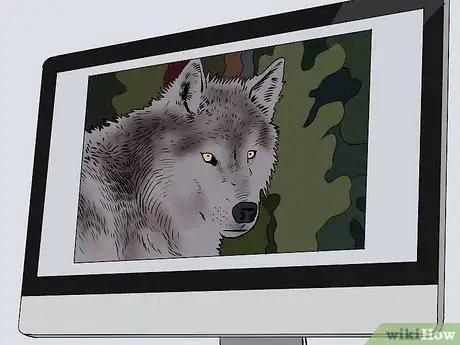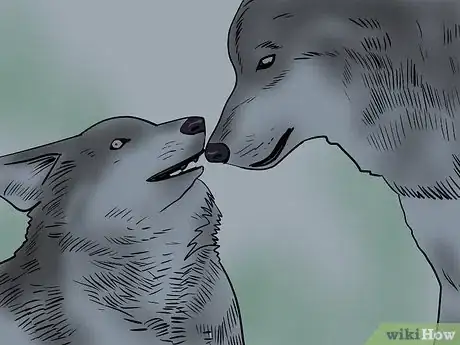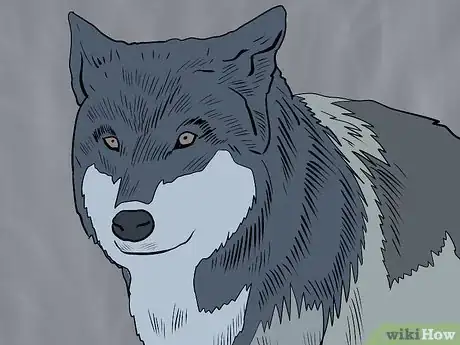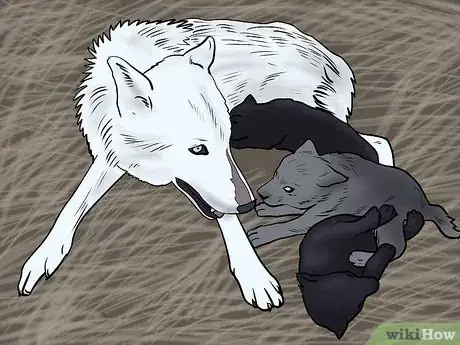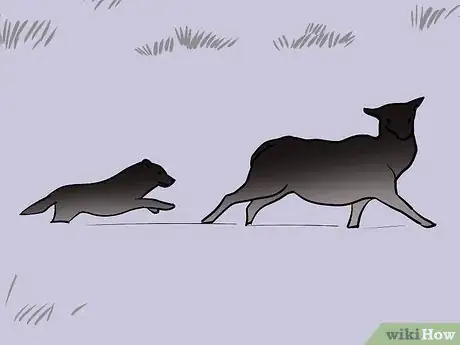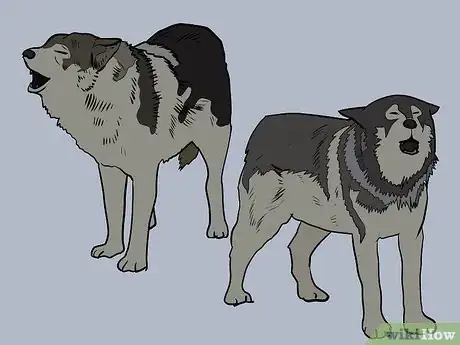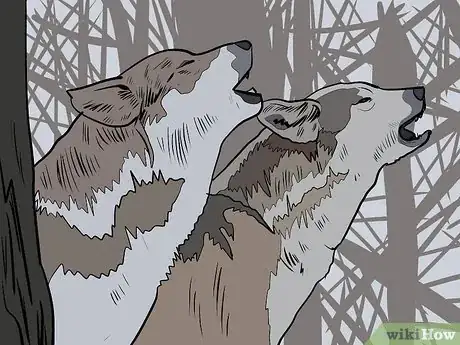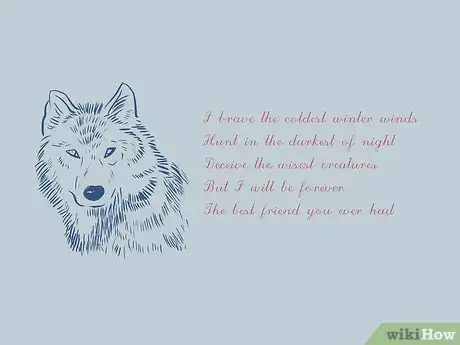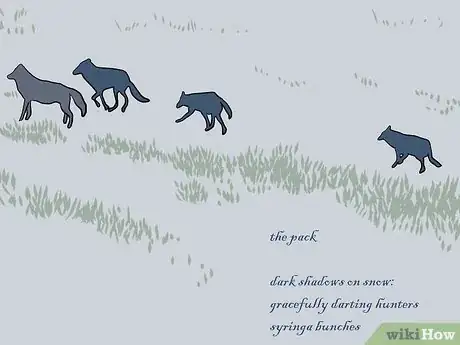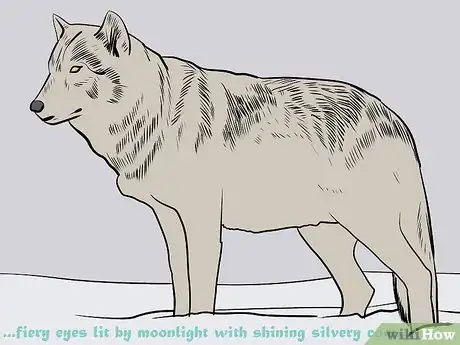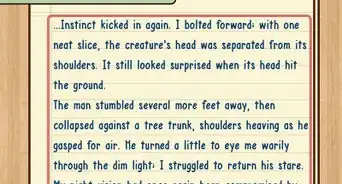wikiHow is a “wiki,” similar to Wikipedia, which means that many of our articles are co-written by multiple authors. To create this article, 26 people, some anonymous, worked to edit and improve it over time.
This article has been viewed 52,585 times.
Learn more...
Wolves are majestic creatures, and writing about them is fun and rewarding. But if you, like many, live in the city, then non-wolf fiction is harder than wolf fiction. Many are daunted by the prospect of writing novels, especially when it's their first time. You could also write poems or short stories, but either way, keep in mind that writing wolf fiction is easy, despite how difficult it may seem at first.
Steps
Doing Research
-
1Research wolves. Actual, real wolves. Start with researching real-life wolves, and not with researching others’ wolf fiction. You can never be sure what are real facts, and what fiction authors have made up. To write good, original wolf fiction, you should get to know real wolves and create your impression of them. Create your understanding of wolves based on reality.
- Watch YouTube videos on wolves. There are a lot of great documentation videos on wolves on YouTube, ready to be watched any time. Look for videos on wolves in their natural habitat. One of the best things you learn from watching is that you get a lot of visual information. You can see all the small things wolves do and develop visual impressions that you can later use in descriptions in your wolf fiction.
- Read non-fiction. Read books and articles on wolves. Learn their habits and their biology. You certainly do not have to get into super-scientific details, but you should know of their family structures, most prominent instincts, normal hunting techniques – stuff like that.
-
2Take notes. The mind is forgetful. Take notes of small things which may easily slip your mind or which simply caught your interest. Some examples may be the way cubs lick adults’ mouths for them to throw up food for the young ones to eat or the way a large submissive wolf will hunch over to seem smaller and less threatening. Or perhaps the way wolves whine when they gather for a hunt or some such.Advertisement
-
3Research humans’ opinions on wolves. Wolves have long lived alongside humans, and they reside in some really old tales. Wolves have come to represent a wide array of things in various cultures. Today, a lot of people hate wolves to the extent of wanting the species extinct, while others seriously love them. Find out why. Research the relationship between wolves and humans. This step might be of less value if you plan on excluding humans entirely from your fiction, but it can still be educating.
-
4Read about mythologies containing wolves. For example, there is the wolf Fenrir in Norse mythology. The legends say that when he breaks loose of his chains, he shall devour the great god Odin and Ragnarok – the end of the world – thus comes. The people of that culture struggled through cold and dark winters – winters which were hard for wolves, as well. And a hungry, desperate wolf may very well attack an unsuspecting human. It makes sense that the people would come to fear wolves and see them as evil predators of the dark.
-
5Listen to opinions. Hear what the wolf-lovers have to say. Hear what the wolf-haters have to say. You certainly don’t have to agree with any of it, but try to see where each person is coming from and what motivates their opinion of wolves. This can inspire you by pointing out a wide range of traits wolves have, that you may not have thought of yourself.
-
6Research wolf fiction. Now that you have taken a good look at reality, it might be a good idea to start looking at the wolf fiction already in existence. See what has been done before. This can be good to get inspiration or find an unexplored area in which you want to set up camp.
- Read pieces of wolf fiction that vary as much as possible. Read Jack London’s classics White Fang and The Call of the Wild (technically the latter is a dog-centered book, but it is a great example of canine fiction). Read an innocent children’s story, read a piece of urban fiction with sexy werewolves for young adults… Try it all!
Early Planning of a Piece of Wolf Fiction
-
1Decide on a setting. This is a good place to start. Determine what world your story will take place in. Our familiar world? Our world with a few changes, or perhaps 3000 years ago? A fantasy world with no humans at all, or a world with humans, elves, orcs, and demons? This decision will have a major impact on the life of your wolves.
- Currently, wolves are scarce in most parts of the world and human hunters pose a major threat – something you can use in your story to create conflict and tragedy. Perhaps you will want to write the story of a wolf set on taking revenge on humans for what they have done to the wolf species.
- In a fantasy world, humans may have such powerful magical skills that they need not fear wolves in the dark winter night. Or the wolves are magical or perhaps even have wings. How might this impact the relationship between wolves and humans?
-
2Decide on the intellect of wolves. Determine how sentient the wolves in your fiction will be. Do they have clear thoughts and speak of the past and the future, just like we humans do? Or are their thoughts without words, but rather full of scents, images, and basic urges like hunger?
- If you are aiming for werewolf fiction – how does your werewolf character’s mind change when they transform? Are their minds the same, or does it change entirely? Is the mind of an un-shifted werewolf the same as that of a human?
-
3Why wolf fiction? Take a minute to think about why you are going to write wolf fiction. Why are the characters in your story wolves? Why are they not humans, tigers, or horses? What do you want to show or have said with your story, and how does having a wolf character help in conveying that message? Figure out what the wolf adds to the fiction.
Writing Stories
-
1Research wolves. This is extremely important, whether you choose to make it realistic or not. Wolf fiction is best when it has plenty of realistic wolf behavior. Research their diet, fur, and hunting as well as anything else you encounter and you're unsure of.
-
2Decide your plot. Short stories usually are about one significant event. You could write about a wolf's last hunt, for example. A novel is more like a set of events that connect somehow. The best ones have complex subplots that surprise the reader yet all fit with each other perfectly. Most mystery novels have this as well.
- Make subplots, such as two cubs playing tag during an event, that will add depth and originality to your story.
-
3Decide how the book is narrated. Is it a wolf telling the story (first person), the author seems to tell the story (third person), or even a character using words like "you" as if you're a character in the story (second person)? Find which one you're best at or stretch your limits. Whatever you do, make sure you enjoy it.
-
4Write the beginning. Many wolf authors start with the main character being born, but you could also introduce the main character to doing something else, such as hunting. You could even start by introducing the mother for the first chapter or chapters, after which the character is born or a friend (canine or otherwise) meets the main character. Add detail, but not so much that it confuses or bores the reader. More than three sentences of detail are too much. Remember, you need to make the reader comfortable with the book. It's like making a friend – make a good first impression and slowly introduce the story.
-
5Build on the story a bit more. Keep introducing the main character and add a few snippets (foreshadowing) of what will become the main plot. Example: "The wolf always wondered what hunting would be like."
-
6For chaptered stories, make the plot clearer after the first chapter, or for short stories, start on the plot soon after the beginning. Subplots, big or small, are always good as a filler. But make sure you don't bore the reader with too many subplots, or by delaying the main plot for too long.
-
7Overcome any writer's block. You might want to write another part of the book, such as the end, pretend to "interview" a character, introduce a new one, or even just read some other wolf fiction such as White Fang by Jack London or Promise of the Wolves by Dorothy Hearst. At the same time, remember to give yourself a chance to relax. You don't have to write or think about wolves, 24/7.
-
8Write the middle of the book. This is where the conflict is and something happens that needs to be fixed. Lace it with suspense as well. The main conflict needs to come down hard, yet be understandable. Have a few down moments (whether downhearted or moments of downtime) but give the reader enough hope for the end.
-
9Finish it off. Make it happy but also leave room for another book if you're willing. The reader needs to feel happy and satisfied with the ending, and the book as a whole.
-
10Revise. Revision is inevitable, and even though many writers dread it, clearing the first draft of all errors, and even adding extra chapters or deleting unnecessary filler, can be quite enjoyable. You may want to let the book sit for at least a week before revising.
Writing Poetry
-
1Decide what the poem is about. Poems are usually about dramatic events, such as a hunt, but a poem could also be a very short story of a wolf making friends, for example.
-
2
There once was a wolf that was fluffy
Its fur was rather stuffy
An example of a haiku would be –
The wolf was howling
it was singing in wolf talk
howl, wolf, howl loudly
Community Q&A
-
QuestionHow do I come up with plots?
 Community AnswerResearch wolf history, such as big things that have happened that threatened wolves, and center it or base it off of one of those events. You can take inspiration from other books, but don't copy the plot, just get ideas! If inspiration doesn't work, you can always try thinking it up from scratch.
Community AnswerResearch wolf history, such as big things that have happened that threatened wolves, and center it or base it off of one of those events. You can take inspiration from other books, but don't copy the plot, just get ideas! If inspiration doesn't work, you can always try thinking it up from scratch. -
QuestionCan I still use Betas, Alphas, Omegas, etc., even though that isn't how wolf packs work?
 Community AnswerThis is fiction, so you can arrange your characters/packs any way you choose. You may choose to include in the story the reason the pack is arranged the way it is, or not. The important thing is to make your characters compelling and relatable.
Community AnswerThis is fiction, so you can arrange your characters/packs any way you choose. You may choose to include in the story the reason the pack is arranged the way it is, or not. The important thing is to make your characters compelling and relatable. -
QuestionCan I still write if I'm a kid?
 Community AnswerOf course you can! The steps outlined in this article should work well for writers of any age.
Community AnswerOf course you can! The steps outlined in this article should work well for writers of any age.






